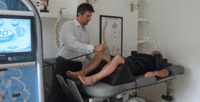BMI offers targeted treatment for sufferers of chronic back and neck pain

Thousands of people across the UK who suffer from back and neck pain, caused as a result of spinal nerve root irritation, could benefit from a new non-surgical treatment available at BMI Fitzroy Square Hospital’s newly launched spinal clinic, part of the hospital’s pain service.
In the UK, back pain is the second most common cause of long term sickness. In 2010 – 2011 7.6 million working days were lost due to back pain and other musculoskeletal disorders. The new treatment, Intervertebral Differential Dynamics (IDD) therapy, was developed in America and is a form of spinal decompression for back and neck pain.
The spinal clinic at BMI Fitzroy Square Hospital has joined together with the Harley Street Spine Clinic, and is part of the hospital’s specialist pain treatment service. IDD therapy is suitable for patients suffering from unresolved pain, in their back, neck, arm or leg as a direct result of spinal nerve root irritation. The treatment offers a high-tech computer controlled therapy that provides relief through the application of carefully controlled pulling forces that gently pull apart targeted spinal segments. This process, known as distraction, relieves the pressure on the affected spinal disc, and any pinched nerves. This promotes the movement and absorption of water, oxygen, and nutrient-rich fluids into the discs. IDD therapy relies on the body’s natural healing mechanism and progressively improves joint mobility and movement, helping to relieve pain.
Robert Shanks, Clinical Director of IDD therapy at BMI Fitzroy Square Hospital, comments: “IDD therapy can offer patients effective long term pain relief without the need for surgical intervention. While still in its infancy here in the UK, IDD is well established in America and Canada where it has rapidly become the standard treatment to bridge the gap between physiotherapy and spinal surgery. IDD therapy isn’t a cure-all solution for all forms of back and neck pain, but as I have witnessed over the last 18 months since using this new therapy, the results for many patients can be life-changing”.
IDD therapy treatments last about half an hour and each session is uniquely tailored, through the use of a specialised computer controlled machine, which uses specific pulling forces and angles according to a patient’s weight and specific areas of damage identified from an MRI scan. To assist in pain relief heat and massage may be included during the therapy session. Other therapy modalities such as core strengthening and stretches are recommended either side of the session. To maximise results it is recommended that each patient completes 20 sessions of IDD therapy. However, some patients may feel relief sooner.
David Newman, 43, suffered with sciatica for 14 months and could barely move or walk prior to his IDD therapy. His consultant had told him as his condition had become so bad that surgery was his only option, “My consultant hadn’t heard of IDD therapy but being from Canada my mother told me about IDD and suggested it might help my condition,” David commented. “I was already booked in for spinal surgery and hunched over in severe pain when I first started IDD therapy, so I was willing to try anything that might help. During my initial consultation I was told that my condition was so severe even IDD may not be successful. Initially the treatment didn’t feel like it was working but after a series of sessions I went through a barrier and noticed, as if by magic the pain going. Now I still go on a regular basis but the pain has gone from ten, on a scale of one to ten, to a one. My life has changed, and I have avoided surgery all thanks to IDD therapy.
Consultant Orthopaedic & Spinal Surgeon, Mr Martin Knight at BMI Fitzroy Square Hospital commented: “Spinal surgery should always be the last option for sufferers of back and neck pain. In reality, most spinal surgeons operate on only a small percentage of patients; here at Fitzroy Square Hospital we take a multidisciplinary approach to treatment and this involves exploring the many non-operative options first. I am greatly encouraged for the future of IDD therapy. It has proved to be an effective non-invasive option for a number of chronic patients who had been left in “No Man’s Land”, meaning that their pain had not improved with standard manual treatments but they did not want, or were not suitable for surgery.”
For more information, visit bmihealthcare.co.uk/fitzroy.

